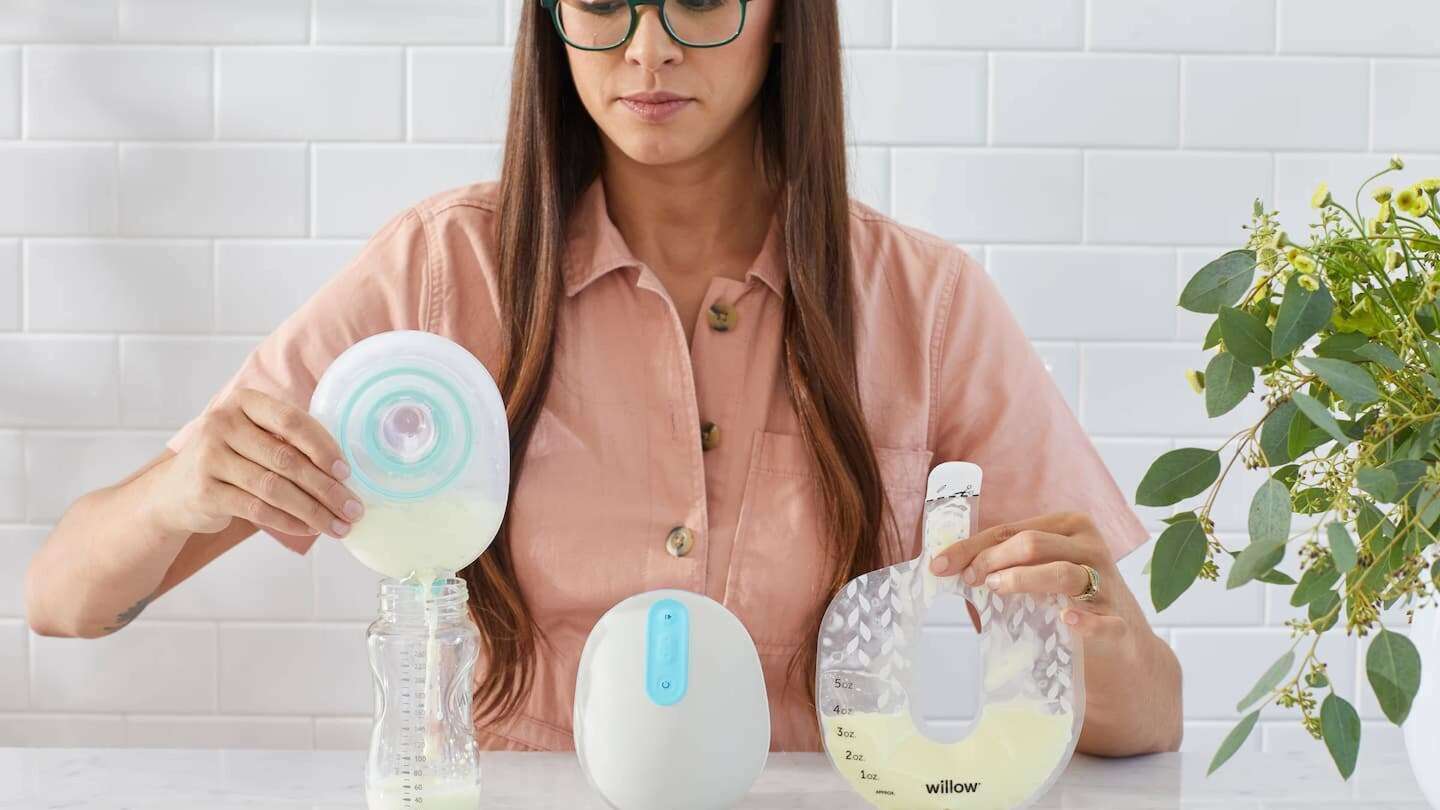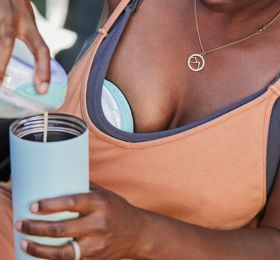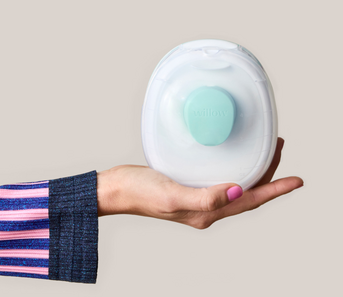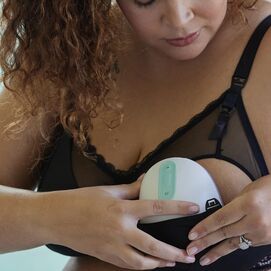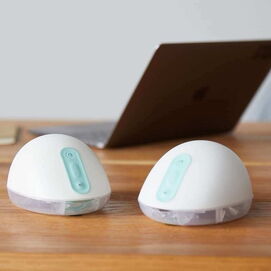If you’re curious about exclusive pumping or are trying to decide if it’s right for you—we’ve got you. Let’s dig into some of those burning questions and give you the tools you need for pumping success.
What Is Exclusive Pumping?
Exclusive pumping simply means to feed your baby using a bottle filled with the liquid gold you’ve pumped. Instead of feeding your baby directly from the breast, you’ll pump periodically throughout the day (or on-demand).
It’s also possible to combine pumping with breastfeeding, which is common for moms who work or play outside of the home. You can breastfeed while you’re with your baby and pump to build milk storage for when you’re away.
Listen up, mama: It’s a #myth that babies who bottle-feed won’t bond. Any time spent with your baby is special. So put the mom guilt behind you—it takes patience and willpower to exclusively pump, too! You got this.
Why Exclusively Pump?
There are many reasons why moms choose to exclusively pump. Some simply choose this method because it fits their lifestyle or because they don’t choose to directly breastfeed. Those reasons are totally cool and valid. Some moms choose to exclusively pump due to other reasons, including:
Delivering a premature baby who is unable to breastfeed
Delivering a baby who has difficulty latching onto the breast
Needing to return to work or school quickly following birth
Worrying about low milk supply
Finding breastfeeding extremely difficult or painful
Having multiples such as twins, triplets or more
Desire to closely monitor baby’s milk intake
Exclusive Pumping vs. Breastfeeding
Both breastfeeding and pumping have their benefits and challenges. Breastfeeding is cost-effective as no other supplies are required. There are also health benefits of breastfeeding for you and your baby.
Pumping enables you to increase your milk supply depending on your baby’s demand. Plus, it gives you more control over feeding times and the ability to return to work and still provide for your baby.
Both breastfeeding and pumping are challenging undertakings that require patience and time. For example, breastfeeding can be unpredictable and it leaves you with the inability to travel independently until your baby is weaned. Pumping requires additional cleaning and maintenance as well as an added expense for pumping supplies.
The Benefits of Exclusive Pumping
Although challenging at times, exclusive pumping has many benefits that make every pump worth it. Exclusive pumping does the following:
Delivers the same health benefits your baby will receive when feeding from the breast
Allows you to return to work or school and still provide breast milk for your baby
Allows your spouse or partner to share in feeding
Enables you to track how much milk your baby is taking in
Allows you to travel and feed your baby on-the-go
Willow 360™ Wearable Breast Pump
Willow 360™ Wearable Breast Pump
Willow 360 is designed with a zero-gravity latch to give you 360° of leak-proof mobility. It's the hands-free breast pump that changed the game.
Willow Go™ Wearable Breast Pump
Willow Go™ Wearable Breast Pump
With hospital-grade suction and a 100% comfort rating, Willow Go pumps quietly and discreetly (no dangling tubes, bottles, or external motors) so you can do it all.
How Does Exclusive Pumping Work?
To exclusively pump, you’ll need to express milk using a breast pump consistently throughout your day. You can then feed the expressed milk to your baby immediately or store it in your fridge or freezer for later use. Simply place the milk in a bottle and voila, you’re ready to go.
How Often Should You Pump?
Newborns will typically eat every 2 to 3 hours. As you first start pumping, it’s best to pump every 2 to 3 hours as well to help you build a healthy supply. As your baby grows, you may be able to pump less depending on their feeding needs and how much milk you wish to store.
It’s normal for moms to pump 8 to 12 times a day, around the clock. The best way to ensure you stay consistent is to keep a schedule and maintain it. A simple schedule could look like this:
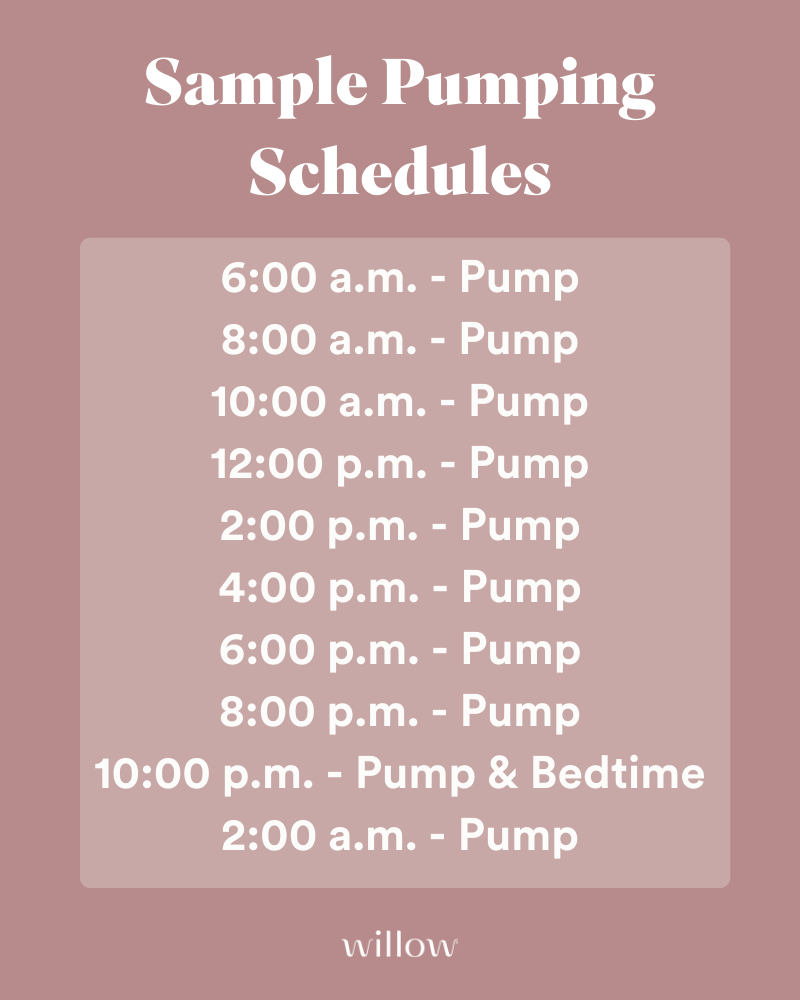
If you’re using a double electric pump, you should be able to pump 15-30 minutes at a time for the best output. This could take longer if you’re using a single pump or a manual pump.
How to Maintain & Increase Your Milk Supply When Exclusively Pumping
It can feel stressful when your baby starts eating more than you can keep up with! In fact, this is the primary reason many exclusive pumpers begin supplementing. While there are tips and tricks to help increase your milk supply, it is just as important to pace bottle fed so you aren’t setting yourself up for an impossible pumping goal. A helpful guideline is to provide one ounce per hour of breastmilk for babies up to 6 months. Pacing the feeding extends the time it takes for your baby to consume a bottle, allowing them to have nutritive and non-nutritive suckling just like they would if they were feeding directly from the breast. Make sure everyone offering your baby a bottle understands paced feeding and how important it is to not overfeed them.
Using various pumping techniques can also help to increase your milk supply. The first being to simply pump more often or for longer periods of time. Be sure to pump for a full 15-20 minutes to make sure you’re completely emptying each breast during every session. If you don’t effectively pump during each session, this will send a signal to your body that it does not need to produce as much milk.Be careful with this tip, because you don’t want to overwork yourself! If you want to try pumping more often, slowly start adding more time to your sessions and make sure it fits in well with your daily schedule.
Keep in mind that how often you pump directly affects your milk supply. If you pump irregularly or at random times throughout the week, this will cause a decrease in how much milk you produce per session. Since milk production occurs on a supply and demand basis, the more often you pump, the more milk your body will supply. Creating a solidified and frequent pumping schedule will stimulate milk production, which is important for sustaining and increasing your milk supply.
Power pumping once a day is another great method that works to increase your milk supply. Power pumping simulates cluster feeding, which is when a fussy baby is constantly on and off the breast looking for more milk. To mimic this behavior, use your pumps on and off for an hour. In a couple of days, you will likely see an increase in your milk supply. In order for this method to work effectively, make sure you are doing it at least 3-4 days in a row to help your body respond to the demand for milk. Power pumping is also a great way to stimulate changes in the components of your milk during growth spurts.
How to Store Your Breast Milk
Storing your breast milk the right way helps protect your baby from harmful bacteria and makes pumping simpler. First, don’t skimp on your milk storage containers—high-quality storage containers ensure your liquid gold is kept airtight and fresh. If using containers instead of bags, they should be made out of glass or food safe plastic.
Portable Breastmilk Milk Cooler
Portable Breastmilk Milk Cooler
Store up to 16 oz of milk at a safe temperature for up to 24 hours with our new patent-pending Portable Breastmilk Cooler. It's the breastmilk chiller you'll bring everywhere.
Storing Milk After Pumping
After you express your milk, you can store it at room temperature for 4 hours. Breast milk can also be stored in the fridge for 4 days and in the freezer for 6 months (up to 12 months is acceptable in a deep freezer).
If storing for later, make sure to label the bag or container with the date you expressed the milk. If using a bag, leave some space for expansion as the milk freezes (2 to 4 ounces is plenty in one container).
When feeding your baby, use the oldest breast milk first. This ensures you don’t waste the milk you’ve already pumped.
Additional FAQs About Exclusive Pumping
How Important is it to Stick to a Pumping Schedule?
Sticking to a pumping schedule can be a challenge, especially for a new mom. In fact, sticking to any schedule can be difficult (washing, sleeping, eating - it's all up for grabs). Skipping a pumping session every now and then is not going to throw you off your rhythm, but it may be important to make the time up later with a power pump or late night pumping session. Frequently missing a pumping session could lead to a decrease in milk supply, and could affect how often your baby eats.
Does Breast Milk Change When Exclusively Pumping?
Very little research has been completed to show the differences, if any, between pumped breast milk and milk directly from the breast.
What we do know is that breast milk changes over time to fit your baby’s needs as they grow. The mama body is an amazing thing.
Does an Exclusive Pumping Schedule Increase Milk Supply?
It most definitely can help! Consistency in your pumping can send your body a signal that says, “Hey, we need to make more milk!” A pumping schedule helps you with that consistency.
How Much Milk Should I Be Producing When Exclusively Pumping?
Every mom is different and so is every baby. Most babies will take in between 25 to 35 ounces of milk a day. When exclusively breastfeeding, you’ll want to make sure you’re pumping at least the amount your baby needs. And to build a milk stash, you may need to increase the number of times you pump.
How many times will it take? That depends on how much milk you make and how often. After the first month, you should have a better understanding of your and your baby’s needs. Then, you can adapt your pumping schedule to fit.
It’s no secret that exclusive pumping is tough. But, so are you. Simplify your pumping sessions with Willow, a wearable breast pump that works how and when you need it to. To learn more about Willow, visit us now.

